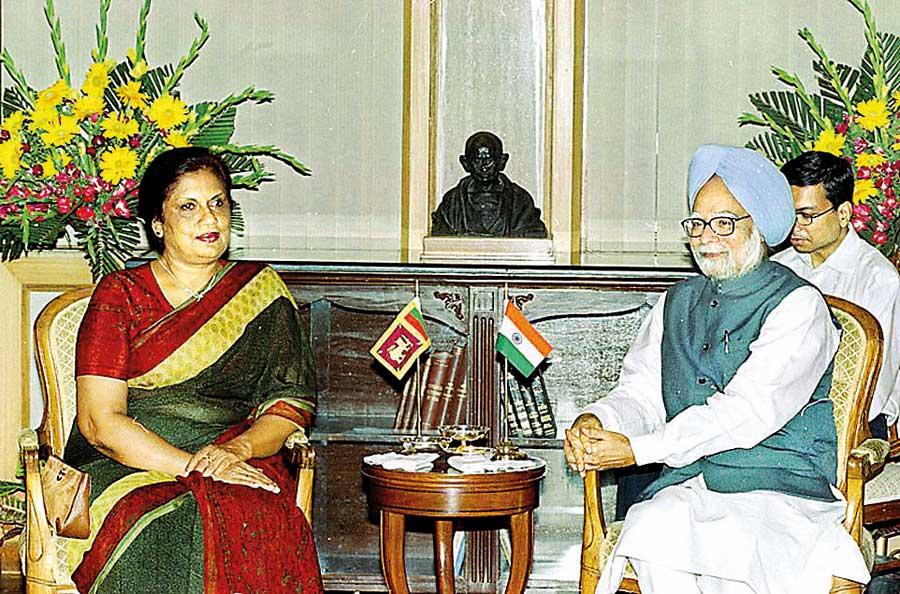Reply To:
Name - Reply Comment
| Diplomacy for a Broken Nation; Looking Back at the Foreign Policy of President Chandrika Bandaranaike Kumaratunga |

President Chandrika Kumaratunga meeting with former Indian Prime Minister, Dr. Manmohan Singh in 2005

During Chandrika Bandaranaike Kumaratunga’s presidency, from 1994 to 2005, her administration pursued an ambitious and diverse foreign policy agenda. Her tenure was characterized by navigating Sri Lanka’s foreign relations amidst regional tensions, global geopolitical changes, and severe internal challenges.
Throughout her presidency, President Kumaratunga had to repair Sri Lanka’s stature on the global stage while managing the intricate domestic challenges presented by a prolonged civil conflict. Her navigation of the geopolitical dynamics of the Indian Ocean region and her diplomatic efforts to address terrorism and insurgency mark her tenure as a period of notable international engagement, despite the substantial domestic obstacles posed by the ongoing civil war.
A return to normalcy with India
This can be considered one of her most significant achievements due to India’s geopolitical importance to Sri Lanka. India’s geographic proximity and regional dominance make it a perpetually important geopolitical partner for Sri Lanka. As Sri Lanka’s closest neighbour, India’s security and economic interests are deeply intertwined with those of the island nation.Sri Lanka’s strategic location at the heart of the Indian Ocean, along major maritime trade routes, also gives it immense value for India in terms of safeguarding its regional influence and access to global markets. The notion that Taiwan functions like a permanent aircraft carrier in China’s backyard can also be applied to the emerging great power of India and the strategic position of Sri Lanka.
A key pillar of Kumaratunga’s foreign policy was achieving a return to normalcy in relation to India.
The relationship between India and Sri Lanka had become strained during the tenures of President Kumaratunga’s two predecessors, R. Premadasa and J.R. Jayewardene. Under Premadasa, who succeeded Jayewardene, relations with India soured due to his confrontational approach and unwillingness to cooperate on the Indian involvement in the ethnic conflict. President Jayewardene, on the other hand, had initially sought closer ties with India, but later grew increasingly distrustful, leading to tensions over the Indian Peace Keeping Force’s (IPKF) involvement in Sri Lanka’s civil war. His efforts to forge closer ties with the United States strained relations with India, leading to further deterioration in their bilateral relationship. President Kumaratunga recognised the dangers posed by this strained and unstable relationship and worked to cultivate a constructive partnership with her counterparts in New Delhi.
Her efforts were built upon the legacy of her parents, Sirimavo and S.W.R.D. Bandaranaike, who had also prioritised Indo-Sri Lankan relations. Under Presidents Kumaratunga’s leadership, the two countries signed several landmark agreements, including the Indo-Sri Lanka Free Trade Agreement (ISFTA) in 1998. This paved the way for a significant expansion of bilateral trade and investment, with India becoming one of Sri Lanka’s largest trading partners.
President Kumaratunga also sought to leverage India’s influence to help resolve the civil conflict. She engaged in regular dialogue with Indian leaders, seeking their support for her efforts to find a political solution to the Tamil question. While these attempts ultimately fell short, her diplomacy helped to maintain a constructive working relationship between the two countries throughout her presidency. Her ability to achieve this during the most intense phase of the civil war, marked by the LTTE’s most effective military campaigns and fierce fighting, is particularly noteworthy.
Masterclass in diplomacy against terrorism
This was a crucial step in Sri Lanka’s efforts to combat the separatist group, as it deprived the LTTE of crucial sources of funding and political support from abroad.
One of President Kumaratunga’s most significant foreign policy achievements was her success in securing international proscription of the LTTE as a terrorist organisation.
President Kumaratunga’s government, led by her Foreign Minister Lakshman Kadirgamar, worked tirelessly to build a global consensus against the LTTE. This included lobbying key allies like the United States and the United Kingdom to designate the group as a terrorist organisation, which they did in 1997 and 2001, respectively. She also leveraged Sri Lanka’s membership in the Commonwealth and other international bodies to further isolate the LTTE on the global stage.
These diplomatic efforts paid dividends, as the LTTE’s international profile and access to funding and resources were significantly diminished; and their propaganda campaigns portraying themselves as wronged freedom fighters took a heavy hit. This, in turn, strengthened the Sri Lankan government’s hand in the ongoing military campaign against the separatists.
 As Sri Lanka’s closest neighbour, India’s security and economic interests are deeply intertwined with those of the island nation
As Sri Lanka’s closest neighbour, India’s security and economic interests are deeply intertwined with those of the island nation
A stormy domestic front
While President Kumaratunga’s foreign policy achievements were substantial, she also faced significant domestic challenges that constrained her ability to fully realise her international agenda. By the time she took office, the civil war had already raged for over a decade and was entering a phase where the LTTE was arguably at its strategic and military zenith. This ongoing conflict remained a major source of instability and a significant drain on the country’s resources.
Early in her first term, the LTTE broke a ceasefire and carried out an attack that destroyed two Sri Lankan Navy vessels in 1995. The LTTE inflicted major setbacks on the government forces, including the Battle of Mullaitivu in 1996 and the Battle of Kilinochchi in 1998. The group, which had developed conventional military capabilities by that point, including artillery and armoured units, also carried out several high-profile terrorist attacks, such as an assassination attempt on President Kumaratunga herself in 1999 that left her injured.
The Kumaratunga Administration’s attempts to find a political solution to the ethnic conflict through power-sharing arrangements and progressive constitutional reforms were repeatedly stymied by opposition from hardline Sinhalese nationalist groups and the constant LTTE attacks during negotiations.
The power sharing arrangement between President Kumaratunga’s People’s Alliance and Prime Minister Ranil Wickremesinghe’s United National Party from 2001 onwards also created significant political tensions that undermined her ability to conduct a stronger foreign policy.
An enduring legacyDespite these challenges, President Chandrika Kumaratunga’s tenure as President of Sri Lanka left an enduring mark on the country’s foreign policy. Her efforts to strengthen ties with the Non-Aligned Movement, SAARC (the Tenth SAARC summit was held in Colombo in 1998 and the agreement for the South Asian Free Trade Area was signed in 2004) and other international organisations, repairing the strained relationship with India, as well as her success in isolating the LTTE internationally, have had lasting impacts on Sri Lanka’s global engagement.
Although her efforts to find a peaceful resolution to the civil war, even in the face of strong domestic opposition, ultimately fell short, they laid the groundwork for how future reconciliation initiatives should be carried out. Had subsequent administrations built upon this foundation, significant progress could have been made in addressing and repairing the severe ethnic and religious tensions that persist in Sri Lanka today.
As Sri Lanka navigates an increasingly complex global landscape, the lessons and legacies of the nation’s fourth Executive President’s foreign policy remains highly relevant to lawmakers today. Her ability to balance severe domestic challenges with an ambitious international agenda serves as a model for future Sri Lankan leaders seeking to elevate Sri Lanka’s standing on the world stage.
The author isa researcher in the study of political communication and political campaigning. He currently works at the BALPP, the leading institute for public policy education in Sri Lanka. You can contact him at [email protected]